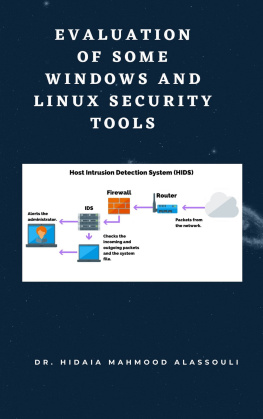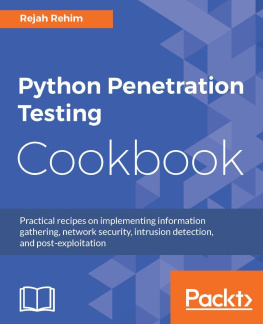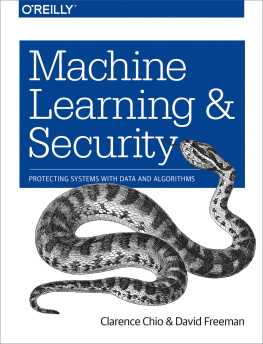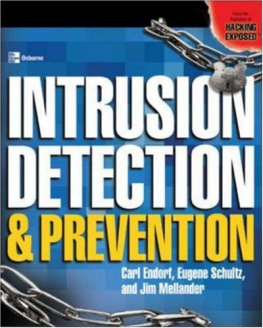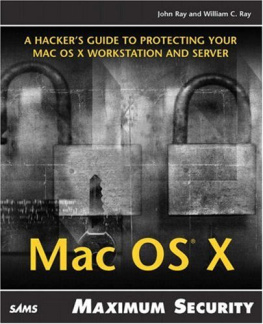Practical Intrusion Analysis
Prevention and Detection for the Twenty-First Century
Ryan Trost

Upper Saddle River, NJ Boston Indianapolis San Francisco
New York Toronto Montreal London Munich Paris Madrid
Capetown Sydney Tokyo Singapore Mexico City
Many of the designations used by manufacturers and sellers to distinguish their products are claimed as trademarks. Where those designations appear in this book, and the publisher was aware of a trademark claim, the designations have been printed with initial capital letters or in all capitals.
The author and publisher have taken care in the preparation of this book, but make no expressed or implied warranty of any kind and assume no responsibility for errors or omissions. No liability is assumed for incidental or consequential damages in connection with or arising out of the use of the information or programs contained herein.
The publisher offers excellent discounts on this book when ordered in quantity for bulk purchases or special sales, which may include electronic versions and/or custom covers and content particular to your business, training goals, marketing focus, and branding interests. For more information, please contact:
U.S. Corporate and Government Sales
(800) 382-3419
For sales outside the United States please contact:
International Sales
Visit us on the Web: informit.com/aw
Editor-in-Chief
Karen Gettman
Acquisitions Editor
Jessica Goldstein
Senior Development Editor
Chris Zahn
Managing Editor
Kristy Hart
Project Editor
Jovana San Nicolas-Shirley
Copy Editor
Sheri Cain
Indexer
Erika Millen
Proofreader
Debbie Williams
Publishing Coordinator
Romny French
Cover Designer
Chuti Prasertsith
Compositor
Jake McFarland
Library of Congress Cataloging-in-Publication Data:
Trost, Ryan.
Practical intrusion analysis : prevention and detection for the twenty-first century / Ryan
Trost.
p. cm.
Includes index.
ISBN-13: 978-0-321-59180-7 (pbk. : alk. paper)
ISBN-10: 0-321-59180-1
1. Computer networks--Security measures. 2. Computer networks--Monitoring. 3. Computer security.
4. Computers--Access control. I. Title.
TK5105.59.T76 2009
005.8--dc22
2009019158
Copyright 2010 Pearson Education, Inc.
All rights reserved. Printed in the United States of America. This publication is protected by copyright, and permission must be obtained from the publisher prior to any prohibited reproduction, storage in a retrieval system, or transmission in any form or by any means, electronic, mechanical, photocopying, recording, or likewise. For information regarding permissions, write to:
Pearson Education, Inc
Rights and Contracts Department
501 Boylston Street, Suite 900
Boston, MA 02116
Fax (617) 671-3447
ISBN-13: 978-0-321-59180-7
ISBN-10: 0-321-59180-1
Text printed in the United States on recycled paper at R.R. Donnelley in Crawfordsville, Indiana.
First printing July 2009
To my loving wife, Kasey, who is pregnant with our first beautiful child.
To my supportive families: To my parents, sister, and brother, who have supported me, motivated me and somehow sustained my endless IT ramblings. And to my wifes family, the Arbacas clan, who have only had to endure my InfoSec rambling for a couple years and still invite me to dinner. I very much appreciate all the help and support!
Contents
Preface
This book was developed to help fill multiple gaps in practical intrusion detection within a single cover-to-cover publication. Traditionally, intrusion detection books concentrate on narrow subject matter that focuses on vendor-specific information, like Snort or Cisco MARS, Intrusion Detection System (IDS) installation, and sensor placement or signature writing. This book incorporates the essential core knowledge to understand the IDS, but it also expands the subject matter to other relevant areas of intrusion interest, such as NetFlow, wireless IDS/Intrusion Prevention System (IPS), physical security, and geospatial intrusion detection. Dont get me wrong...the previously mentioned books are the foundation of my security knowledge, but as the industry matures to include various facets of incursion, its books should incorporate those facets into a single publication so security aficionados dont have to fracture their attention across so many titles.
Who Should Read This Book
This books audience is any and all security practitioners; whether youre an entry-level security analyst, a chief security officer, or even a prospective college student researching a career in network security. Every chapter might not provide a silver-bullet solution that protects your company from every well-versed attacker. But, as you peel back the onion layers, you will find a combination of included security defenses that help ensure your companys security posture and out-endure even the most motivated attacker(s).
How to Read This Book
Although, at first glance, the chapters might seem independent, a structure guides you from the first few chapters that provide a fundamental foundation, including is the perfect transition from beginner to more advanced topics of new intrusion detection strategies consisting of wireless IDS/IPS, network behavioral analysis (NBA), converging of physical and logical security, and geospatial intrusion detection. Several traditional chapters explore new approaches, including ones that cover IDSs, vulnerability signature dissection, and Web Application Firewalls (WAF).
I was lucky enough to have several knowledgeable friends that, with some begging and pleading, agreed to include their extensive security insight, experience, and opinions. I avoid duplicating materials presented in other books because I want to fill the gaps of current security initiatives and/or explore the arena of new concepts and strategies.
How This Book Is Organized
This book follows a compartmentalized organization because each chapter focuses on specific intrusion techniques. The beginning of this book introduces basic networking terminology, and it transitions into providing an overview of intrusion detection, which caters to the InfoSec newbies and finally dives into more sophisticated and advanced intrusion defenses. Here is a brief description of each chapter:
, focuses on basic network structure and briefly explains the anatomy of TCP/IP and OSI. Most IT-related books must include some introductory chapter to either define the foundation of the technology or refresh readers that might not deal with it in their daily lives; this book is no different. It is not meant to be an in-depth analysis, but it eases you into the more sophisticated work to come.
, explores some common network security practices, including vulnerability assessments, packet sniffing, IDS, file integrity checking, password auditing, wireless toolkits, exploitation toolkits, and network reconnaissance tools. Network security heavily relies on the tools used to see the traffic. However, as the chapter title indicates, a majority of this chapter concentrates on mainstream monitoring capabilities and the never-ending battle between using a tap or SPAN for monitoring purposes.
, provides you with insight into the IDS industry by introducing fundamental concepts and then progressively jumping into more complex topics, including evasion techniques, signature dissection, and a look into the Snort and BRO IDSs, while simultaneously providing as little duplication of previous material as possible. Most IDS books written in the past focus solely on Snort, snort.conf (Snorts configuration file), and the signature syntax. However, few publications truly clarify the distinction between writing a signature looking for an exploit versus writing a signature identifying a systems vulnerability. Finally, the chapter ends with an assessment of two open source systems, Snort and Bro, which take different approaches to intrusion detection.



